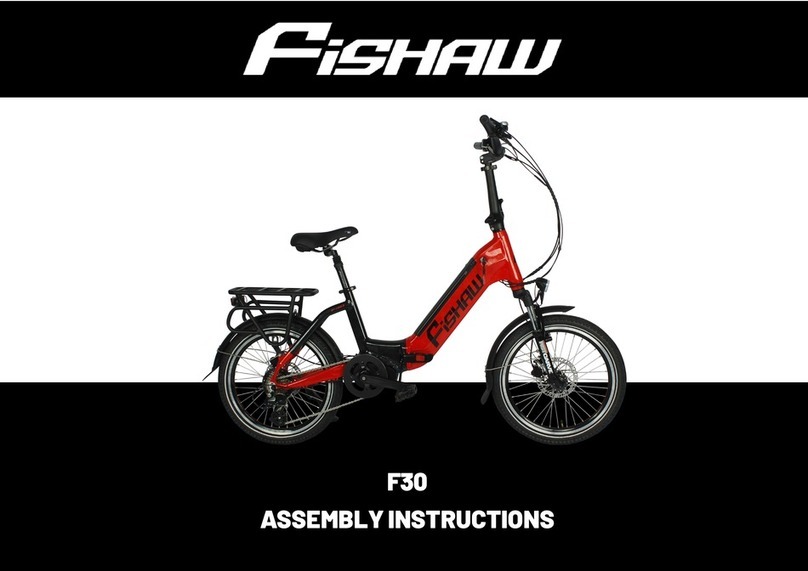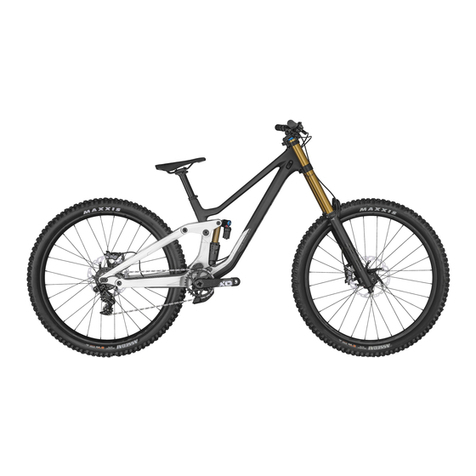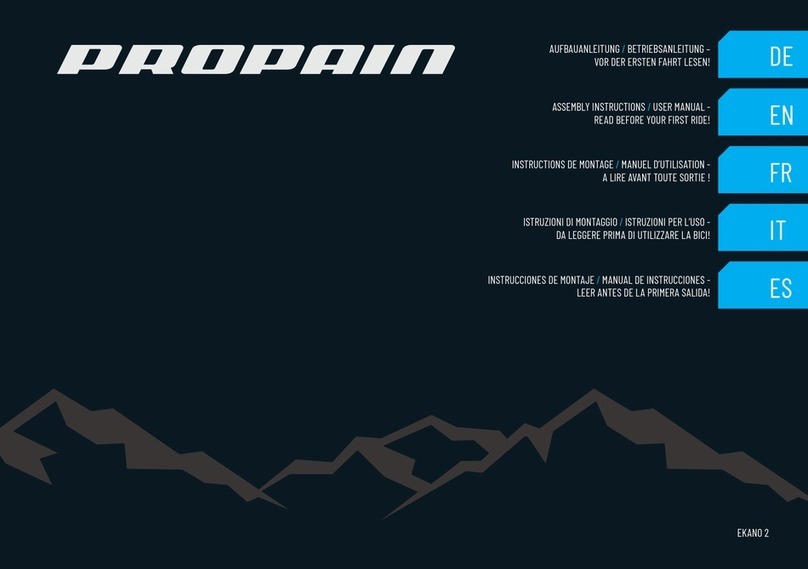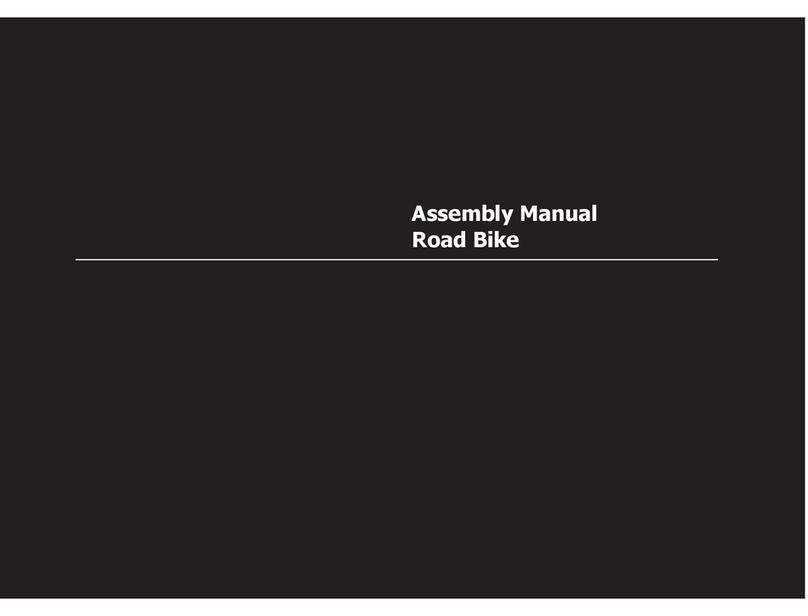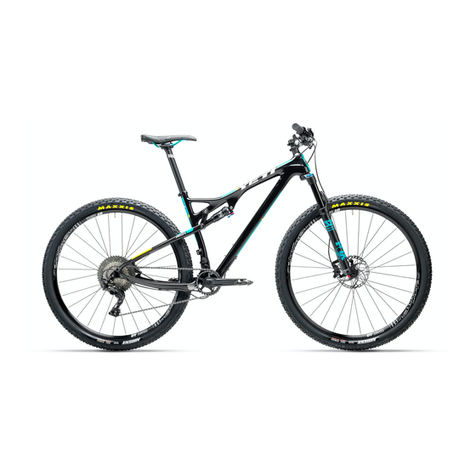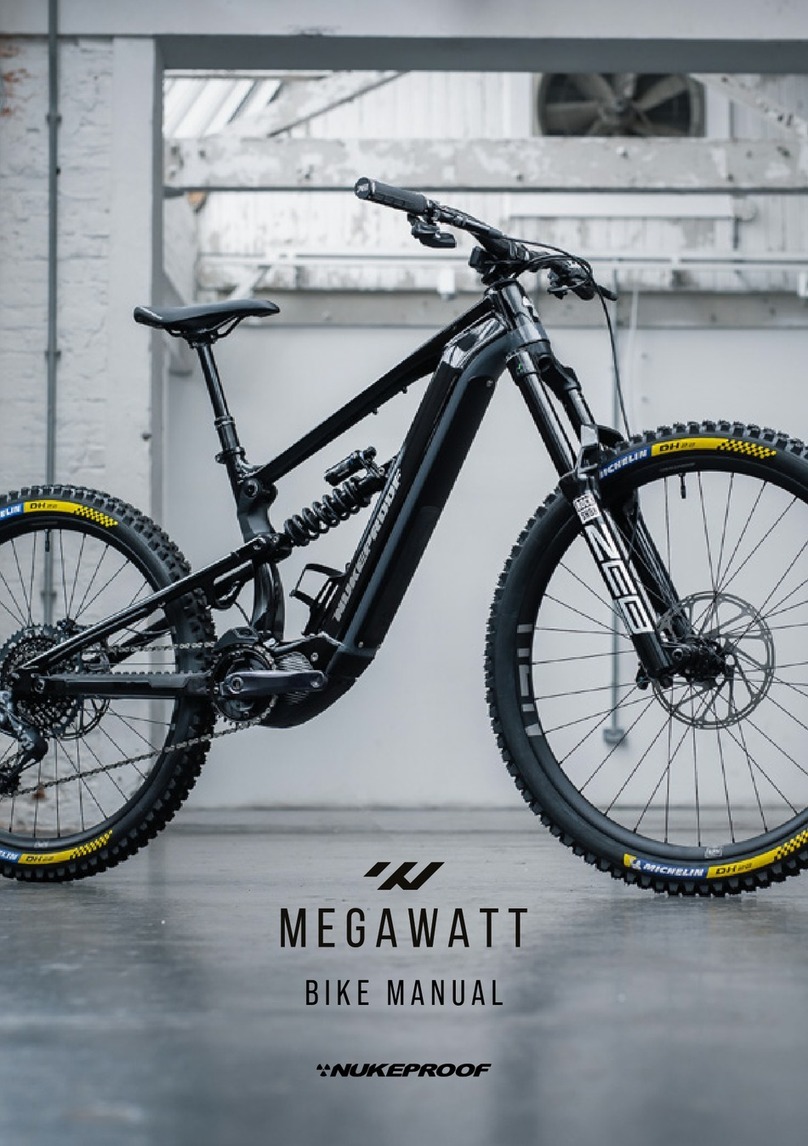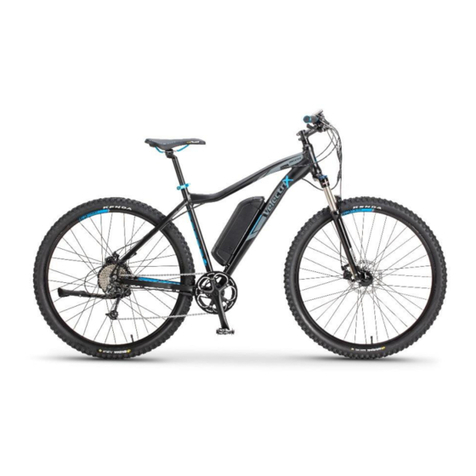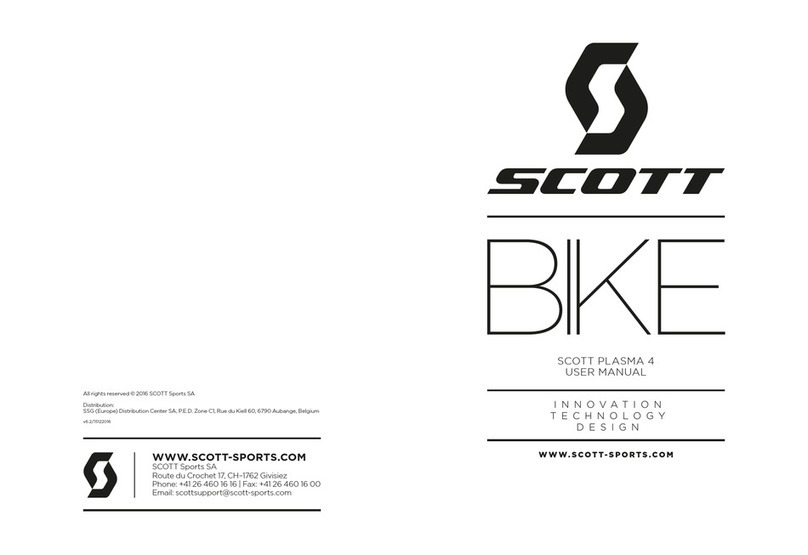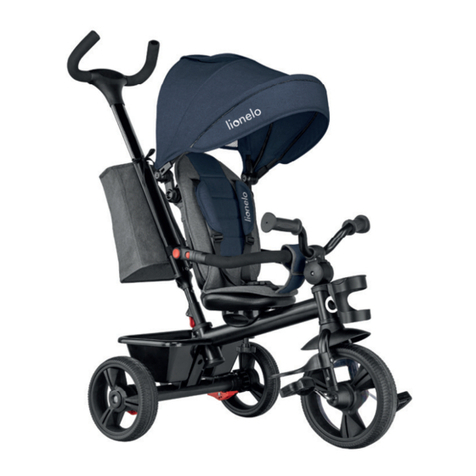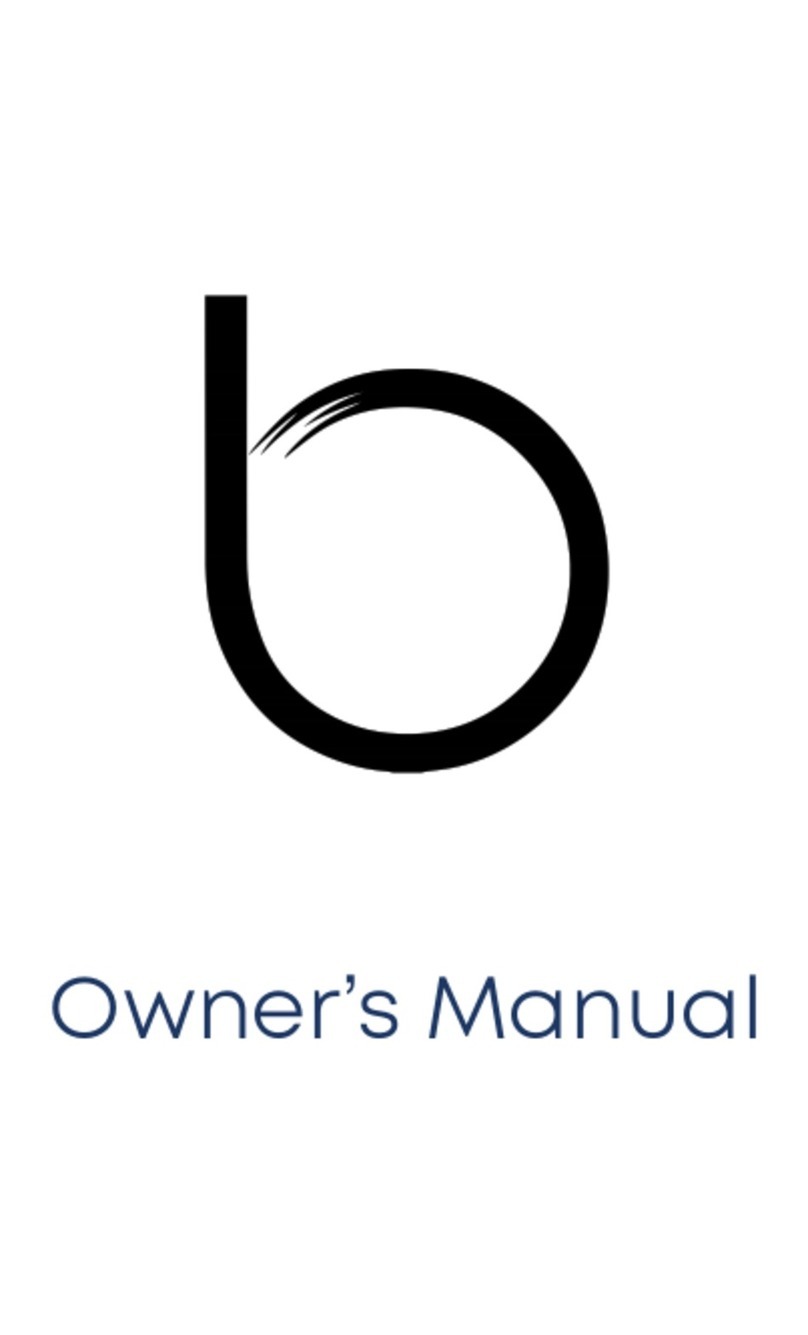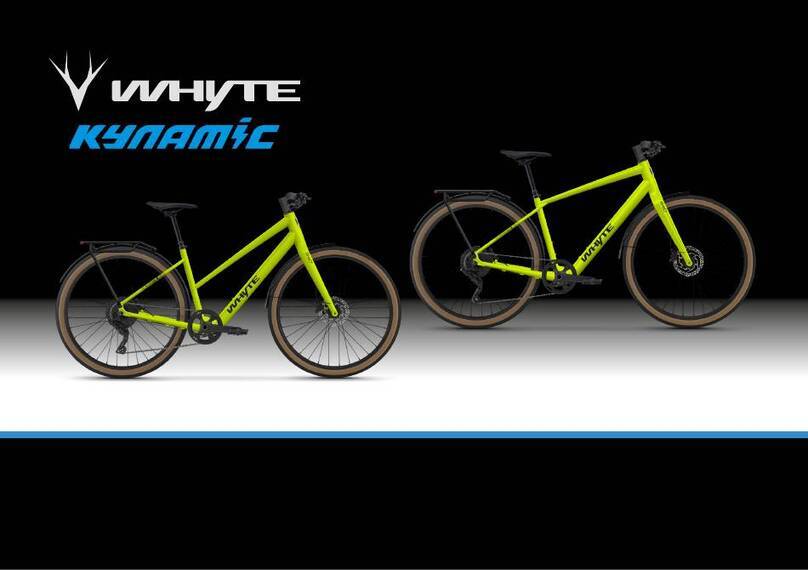FiSHAW UB200 User manual

E-BIKE MANUAL

Page 1of 64
1. FiSHAW UB200 Urban E-Bike Component Diagram……………………………………………………………………………2
2. FiSHAW Mid-Drive Urban E-Bike Components Diagram …………………………………………………………………….3
3. FiSHAW E-Mountain Bike Components Diagram………………………………………………………………………………..4
4. FiSHAW Folding E-Bike Components Diagram…………..……………………………………………………………………….5
5. General Safety Instructions…………………………………………………………………………………………………………….6-9
6. Riding a Fishaw Electric Bike- Special Features……………………………………………………………………………..9-11
7. The Proper Care of Your Rechargeable Battery…………………………………………..………………………………12-15
8. Before Each and Every Ride………………………………………………………………………………………………………..15-16
9. Accidents- Checklist Before Continuing to Ride…………………………………………………………………………..16-19
10. First Ride-Checklist………………………………………………………………………………………………………………….19-21
11. Adjustments of Your E-Bike to Suit the Rider………………………………………………………………………………22-27
12. Adjusting the Saddle to the Correct Height………………………………………………………………………………………22
13. Adjusting the Height of The Handlebars……………………………………………………………………………………..23-26
14. Correcting the Horizontal Tilt of The Saddle and The Forward to Back Position……………………………….26
15. Adjusting Saddle Position and Tilt……………………………………………………………………………………………………26
16. Adjusting the Tilt of the Handlebars and Brake Levers………………………………………………………………..26-27
17. Quick-Releases-Instructions for Use……………………………………………………………………………………………28-29
18. Braking Systems………………………………………………………………………………………………………………………….29-32
19. Gears………………………………………………………………………………………………………………………………………….32-38
20. Chain-Care and Maintenance……………………………………………………………………………………………………..38-39
21. Wheels and Tyres……………………………………………………………………………………………….………………………39-44
22. Headset………………………………………………………………………………………………………………………………………44-45
23. Suspension…………………………………………………………………………………………………………………………………45-50
24. Lights…………………………………………………………………………….……………………………………………………………50-51
25. Things Worth Knowing About Your FiSHAW Electric Bike……………………………………………………………51-53
26. Mudguards/Wheel Protectors…………………………………………………………………………………………………………52
27. Transporting Baggage………………………………………………………………………………………………………………….….52
28. Taking Children with You……………………………………………………………………………………………………………53-54
29. Transporting The Fishaw Electric Bike………………………………………………………………………………………..55-56
30. Notes On Care And Servicing…………………………………………………………………………………………………..…56-59
31. Servicing and Maintainance……………………….…………………………………………………………………………………..59
32. Warranty……………………………………………………………………………………………………………………………………61-64
Assembly Instructions QR Code Display Operating Manuals QR Code
I

Page 2of 64

Page 3of 64

Page 4of 64

Page 5of 64

Page 6of 64
GENERAL SAFETY INSTRUCTIONS
Dear FISHAW customer,
FISHAW electric bikes have been designed to
provide you with an electric bike of high quality
and performance. Each component of your
new FISHAW electric bike has been designed,
manufactured, and assembled with care and
expertise by our FISHAW team. Your electric
bike was given a functional check at its final
assembly, before leaving our factory. This
ensures your electric bike arrives with little
assembly required and peace of mind that your
electric bike has passed our strict quality
control standards.
This manual contains information on the
proper use of your FISHAW electric bike, its
maintenance and operation. Read these
FISHAW operating instructions thoroughly.
Electric bicycle technology is advancing at a
rapid pace.
Before riding your new FiSHAW electric bike it
is imperative to be sure to carry out the
functional checks in the chapter “Before Each
Ride” on your FISHAW electric bike.
Pay attention to this warning symbol,
throughout the manual! It alerts you to
actions that may cause injury to the rider,
other people, damage to property and or
damage to your electric bike when using your
FISHAW electric bike.
This symbol gives you information
about how to operate your FISHAW electric
bike or refers to operating instructions that
deserve special attention.
All FISHAW electric bike models, comply with
the requirements of the European standards
EN 15194 for pedelecs; which Australia has
adopted as its own standard.
These operating instructions are not intended
to help you assemble a FISHAW electric bike
from individual components or to repair it.
Assembly Instructions for all our models can be
found on our website.
Link to FiSHAW E-Bike Assembly Instruction
Manuals: https://fishaw.com/assembly-
instructions/
These operating instructions focus on your
newly purchased FISHAW electric bike and
standard components and provides the most
important information and warnings.
In conjunction with this manual, please observe
the system instructions of the drive
manufacturers and the instructions of the
component manufacturers, found on their
respective websites. Please contact your
FiSHAW representative if you require
assistance obtaining this information.
When doing any adjusting and maintenance
work, be aware that the instructions in this
manual only refer to FISHAW electric bikes.
The information contained in this manual is not
applicable to any other type of electric bicycle.
Be aware that these instructions may
require further explanation, depending on the
experience and/or skills of the person doing
the work. For some jobs you may require
additional (special) tools or supplementary
instructions. This manual cannot teach you the
skills of a bicycle mechanic.
Before riding, pay attention to these
instructions that are very important to every
cyclist. Never ride without a properly adjusted
helmet. Make sure to wear suitable, bright

Page 7of 64
clothing, and shoes. Always ride carefully on
public roads and observe the traffic rules so as
not to put yourself or others in danger.
This manual cannot teach you how to
ride. Please be aware that cycling is a
potentially dangerous activity that always
requires the rider to stay in control of his or
her FISHAW E-Bike. Be aware from the
moment you set off that you have suitable
riding experience and expertise.
Like any sport, cycling involves the risk of
injury and damage. By choosing to ride an e-
bike, you assume the responsibility for these
risks. On an e-bike you have no protection
around you like you have in a car (e.g.
bodywork, ABS, airbag). Always ride carefully
and respect the other road users. Never ride
under the influence of drugs, medication,
alcohol or when you are tired. Do not ride
with a second person on your FISHAW e-bike,
unless on an attached passenger seat (e.g.,
child seat), and never ride without having
both hands on the handlebars.
Observe the legal regulations for your state,
concerning off-road cycling and cycling on
public roads with FISHAW electric bikes.
Respect the natural environment when riding
through national parks and in the open
countryside. Only use your FISHAW Urban e-
bikes on well-maintained trails and hard-
surface roads.
Always remember that you travel
rapidly and quietly when you are riding a
FISHAW electric bike. Do not startle
pedestrians or other cyclists. Always make
others aware of your presence well ahead of
time, by ringing your bell and use the brakes
to avoid accidents.
Familiarize yourself with your FISHAW electric
bicycle. For more information in this regard,
read the chapter “Riding a FISHAW Electric
Bicycle —Special Features”.
First, we would like to familiarize you with the
various components used on your FISHAW
city/trekking electric bicycle. Observe the
component description on the front pages of
these FISHAW operating instructions. There
you will find a FISHAW hybrid/urban electric
bike, a FISHAW trekking/mountain electric bike
and a FiSHAW Folding electric bike, showing all
the essential components so that you can
easily locate the components as they are
referred to in this user’s manual.
For your own safety never do any work
or adjusting when servicing your bike unless
you feel absolutely sure about it. If you are in
doubt or if you have any questions, contact
your qualified bicycle mechanic or FISHAW
directly.
Please note: Do not hitch yourself and your
bike to a car. Do not ride freehand. Only take
your feet off the pedals, if required by the
condition of the road.
Keep in mind that every type of bike is
designed for a specific use. Be sure to use your
FISHAW electric bicycle only for its intended
use, as it may otherwise not withstand the
stress and could fail and cause an accident
with unforeseeable consequences! If you use
your bike for anything other than its intended
purpose, the warranty will become void.
URBAN E-BIKES
FISHAW urban and folding e-bikes are intended
for hard-surface roads, i.e., for tarred roads
and bicycle lanes or gravel off road tracks.
Observe the traffic rules when riding on public
roads. FISHAW e-bikes are not suitable for
competitive use of any kind.

Page 8of 64
FISHAW bikes of this category are designed for
riding on hard-surface roads, where the wheels
remain in permanent contact with the ground.
The rider's maximum weight including baggage
should not exceed 120 kg for the Urban E-Bikes
and 130 kg for the E-Mountain Bikes.
FISHAW e-bikes are not suitable for stair riding,
jumps, slides, wheelies, tricks.
For your own safety, do not overestimate your
riding skills. Please note that though looking
easy the tricks of a professional are dangerous
and can cause serious injury. Always protect
yourself with suitable clothing.
When riding a FISHAW electric bicycle,
wearing a helmet is compulsory and must
comply with Australian standard AS/NZS
2063.
FISHAW Urban electric bicycles are designed
for cycling exclusively on paths and roads with
a compacted surface. They are equipped with
tyres suitable for riding on grass and gravel
surfaces, making them suitable for most rail
trails and touring. FISHAW urban electric bikes
are generally suitable for off-roaduse, as long
as they are ridden on well-maintained trails
and tracks with compacted surfaces and no
large rocks or holes.
Your FISHAW electric bike is designed for
a maximum overall weight including rider and
baggage. The overall weight is 120 kg for Urban
models and 130 kg for Mountain Bike models.
Be sure to use your FISHAW electric
bike only for its intended purpose, as it may
otherwise not withstand the stress and fail.
Risk of an accident!
Please note that there are different
types of pedelecs and e-bikes which are
subject to
different legal framework conditions. All
FISHAW E-Bike’s conform to the Australian
regulations for Pedalecs (pedal assist bicycles).
POWER-ASSISTED PEDAL CYCLE (AB)
A pedal cycle to which is attached one or more
auxiliary propulsion motors having a combined
maximum power output not exceeding 200
watts; or
A ‘Pedelec’.
PEDELEC - A vehicle meeting European
Committee for Standardization EN 15194:2009
or EN 15194:2009+A1:2011 Cycles - Electrically
power assisted cycles - EPAC Bicycles.
To be considered a Power Assisted Pedal Cycle
or a Pedelec, the following requirements apply:
Power Assisted Pedal Cycle –maximum power
output 200 watts
The auxiliary motor/s must not be capable of
producing a combined maximum power output
exceeding 200 watts, whether or not the
motor/s is operating.
2. Power-assisted pedal cycle –maximum
power output 250 watts (a ‘Pedelec’)
Motor has no more than 250 watts.
Compliant with EN 15194:2009 or EN
15194:2009+A1:2011
Top power assisted speed limited to 25
kilometres per hour.
A person must still be able to propel the bicycle
via pedals without the motor operating.
Road Safety requirements vary slightly from
State to State:

Page 9of 64
New South Wales:
http://www.rms.nsw.gov.au/documents/roads
/safety-rules/standards/vsi-27-mopeds-power-
assisted-pedal-cycles.pdf
Queensland:
https://www.qld.gov.au/transport/safety/rule
s/wheeled-devices/bicycle#legal-motorised
Victoria:
https://www.vicroads.vic.gov.au/safety-and-
road-rules/cyclist-safety/power-assisted-
bicycles
Power assisted bicycles with power output
greater than 200 W (excluding pedelecs)
Bicycles with motor power output exceeding
200 W, excluding pedelecs, are classified as
motor vehicles. Unless registered, these
bicycles are illegal to use on Australian roads.
Engine kits for bicycles
Engine kits that the consumer can fit on a
bicycle are available for purchase in Australia.
State Road Traffic Authorities have expressed
concern about these kits. Kits can be either
electric or petrol powered, have power output
exceeding 200 W, and allow bicycles to reach
speeds more than 60 km/h.
When engine kits with power output
exceeding 200 W are fitted on bicycles, the
bicycle is classified as a motor vehicle and
unless registered (and therefore compliant
with Australian Design Rules) are illegal to use
on Australian roads.
RIDING A FiSHAW ELECTRIC
BIKE- SPECIAL FEATURES
Your FISHAW electric bike is designed to be
used like a conventional bike. The unique riding
experience, however, starts when you operate
the drive system. At that moment, the
assistance generated by the 250 W motor
increases with its high torque the stronger you
pedal.
Set off for your first ride by selecting the
lowest level of drive assistance. Gradually get
used to the additional power. Slowly approach
the potential of your FISHAW electric bike in an
area free of traffic.
Practice typical riding situations such as
starting off and braking, tight corners and
riding on narrow cycle paths and lanes. This is
where a FISHAW electric bike really differs
from a conventional bike.
Be aware that the brakes of your FISHAW
electric bike are always more effective than the
drive. If you face any problems with your drive
(e.g., because it pushes you forward in front of
a bend), slow down your FISHAW electric bike
carefully. This is only applicable to rear-hub
drive systems (motors).
RIDING WITH DRIVE ASSISTANCE
The system is switched on and off at the
buttons of the control panel on the handlebars.
Different assistance modes can be selected, the
remaining capacity of the rechargeable battery
is displayed, and the different functions of the
cycle computer can be selected. Detailed
operating instructions for the Drive (Display)
Systems for each model are found in the
footer on our website: -
https://fishaw.com/manual/
When switched on, the system activates during
pedalling and the drive assistance is available.
Sensors measure your pedalling movements
and control the fully automated drive

Page 10 of 64
assistance according to the selected assistance
mode. The level of the additional propulsion
depends on the assistance mode, your speed
and the amount of force applied to the pedals.
The assistance switches off when you reach a
speed of more than 25 kmh.
Keep in mind that you may have to change
your riding habits: Do not mount by placing
one foot on the pedal and by trying to throw
the other leg over the saddle. The FISHAW
electric bike would set off suddenly unless the
assistance level is set to “0” on your Display.
The motor will engage as soon as you move
the pedals on all other levels of assistance!
Stop pedalling earlier than you are used
to before riding a turn or bend. Otherwise,
there may be too much propulsion and your
cornering speed may be too high.
Do not give in to the temptation to always ride
in a high gear, due to the strong motor. Shift
gears frequently in the same way that you are
used to doing with a conventional bike to make
your own contribution to your forward
progress as efficient as possible. Your cadence
should always be in a smooth flow. In other
words, you should pedal at more than 60 crank
rotations per minute.
Keep in mind that the other road users
are not yet used to the new electric bicycles
and their higher speeds. Ride with this fact in
mind and anticipate the actions of other road
users. Be aware that the speed you ride at will
be clearly faster than you are used to.
Therefore, keep these facts in mind and be
ready to brake whenever unclear or possibly
dangerous situations come into your field of
vision.
Do a test ride in an unfrequented area
to make yourself familiar with the riding
characteristics of your FISHAW electric bike.
Never ride without a helmet!
Do not step on the pedals before sitting
in the saddle, select the lowest level of
assistance (level 1) and be ready to brake
when you set off. Risk of an accident!
Keep in mind, when riding the UB200
Urban Model, that due to the higher driving
power at the rear wheel the risk of an
accident increases with slippery roads (due to
wetness, snow, gravel etc.). This applies more
when riding bends. Risk of an accident!
Please note that car drivers and other
road users may underestimate your speed.
Always wear bright clothing. Therefore,
always ride on public roads with this fact in
mind and anticipate the actions of other road
users. Risk of an accident!
Keep in mind that pedestrians do not
hear you when you approach at high speed.
Therefore, ride particularly defensively when
using cycle lanes and cycle/footpaths to avoid
accidents. If necessary, ring the bell to warn
others.
RANGE —USEFUL INFORMATION FOR A
LONG RIDE
How long and how far you can benefit from the
auxiliary drive depends on several factors, i.e.,
the road conditions, the weight of the rider and
any additional load, the rider's pedal force, the
assistance level chosen, (head)winds, frequent
stops, temperature, weather conditions,
topography, tyre pressure, etc.

Page 11 of 64
The charge state of your rechargeable battery
can be read from the display/controller, on the
handlebars.
The batteries of FISHAW electric bikes have no
memory effect.
It is recommended that you charge the battery
after every long ride. Avoid any deep discharge
of the rechargeable battery.
For more information see the chapter,
“Important Information for The Proper
Care of Your Rechargeable Battery”.
To extend the range it is recommended
that you ride with low assistance or no
assistance at all on level or downhill trails and
only select maximum drive assistance with
headwinds, heavy additional loads and/or
when climbing hills.
You can extend the range by:
•checking the tyre pressure regularly,
i.e., once a week with a pressure
gauge, and changing it, if necessary.
•shifting gears down in front of traffic
lights and intersections or in general in
cases of stops and by setting off in low
gears.
•shifting gears regularly, as you would
do on a bike without drive assistance.
•not only riding in high gears
•riding with these facts in mind and
always looking ahead to avoid any
unnecessary stops.
•reducing your additional load, i.e.,
without any unnecessary baggage
•storing your battery in your home and
installing it only shortly before you set
off on your bike in cooler weather,
when it is cold.
•not parking your FISHAW electric bike
in the blazing sun
lf your battery does not have enough
capacity to reach your destination, you will
benefit from the advantage of the fact that you
are riding a hybrid electric bike. The advantage
being that; without drive assistance you can
ride your FISHAW electric bike like a
conventional bike, with an unlimited range and
almost without compromising on riding
characteristics.
If your battery runs empty during the
ride, do not recharge the battery with any
other charger, even if it happens to be fitted
with an identical connector type. Risk of
explosion! Only charge your battery with the
supplied charger!
Riding Without Drive Assistance
You can also use your FISHAW electric bike
without drive assistance, i.e., just like a
conventional bike.
Observe the following points when riding
without the rechargeable battery:
- If you want to ride without drive assistance
with a mounted battery, you can switch on the
drive control panel of your FISHAW electric
bike to benefit from the functions of your cycle
computer. Just select 0 as the level of power
assistance.
- After you have removed the battery of
your FISHAW electric bike: Keep the
connections of the rechargeable battery free
of dirt and moisture.

Page 12 of 64
IMPORTANT INFORMATION
FOR THE PROPER CARE OF
YOUR RECHARGEABLE BATTERY
Remove the rechargeable battery if you do not
use your FISHAW electric bike for an extended
period of time (e.g., on vacation). Store the
rechargeable battery in a dry room at
temperatures between 5 and 20 degrees
Celsius. The state of charge should be 50 to
70% of the charging capacity. Check the state
of charge, if the rechargeable battery is left
unused for more than two months, and
recharge it in between, if necessary.
Clean the battery housing with a dry or, if at all,
a slightly moist rag. Do not direct the water jet
of a high-pressure cleaner at the rechargeable
battery, as there is a risk of water entry and/or
short-circuit.
Charge your battery only with the
supplied charger. Do not use the charger of
any other manufacturer, not even when the
connector of the charger matches your
rechargeable battery. The rechargeable
battery can heat up, catch fire, or even
explode!
Keep the rechargeable battery and the
charger out of the reach of children!
We recommend that you charge your battery
during the day and only in dry rooms which
have a smoke or a fire detector; but keep it out
of your bedroom. Place the battery during the
charging process on a non-flammable surface!
Unplug the battery once it has been charged
up.
Keep the rechargeable battery and the
charger away from moisture and water during
the charging process to prevent electric shocks
and short circuits.
Do not use a rechargeable battery or a
charger that is damaged or faulty. If you are in
doubt or if you have any questions, contact
your FISHAW customer service representative.
Do not expose your battery or the
charger to the blazing sun.
Do not charge any other electrical
devices with the supplied charger of your
FISHAW electric bike!
The drive is not approved for steam
cleaning, high-pressure cleaning, or cleaning
with a water hose. The contact of water with
the electrical components or the drive can
destroy the units. The individual drive
components can be cleaned with a soft rag
and neutral detergents. You may use a moist
rag, but not excessive water. Keep the
rechargeable battery dry and do not submerge
it! Risk of explosion!
Make sure your rechargeable battery is
in good condition. Do not open, disassemble,
or crush the battery. Risk of explosion!
Make sure your rechargeable battery is
not exposed to mechanical impacts.
Keep your battery away from fire and
heat. Risk of explosion!
Batteries must not be short-circuited.
Store them in a safe storage area and make
sure the battery is not short-circuited
accidentally (e.g., with another battery). In

Page 13 of 64
addition, the rechargeable battery must not
be stored inappropriately, e.g., in a box or in a
drawer where they can be short-circuited by
other conductive materials or where they can
short-circuit each other. Do not place any
objects in the storage area (e.g., clothes).
Make sure to use the battery only for
the FISHAW electric bike for which it is
designed.
When you remove your battery from
your e-bike for charging it; you should protect
the connections, e.g., with a plastic bag
against rain, water, moisture, and dirt. If the
connections of the rechargeable battery are
soiled, clean them with a dry rag.
Your FISHAW electric bike should NOT
be left in the open during charging!
Make sure not to discharge your
rechargeable battery completely (also
referred to as deep discharge). This occurs
often when the battery has run out
completely and the FISHAW electric bike is left
uncharged for a number of days. Depth
discharge will affect the rechargeable battery
of your FISHAW electric bike permanently! A
deep-discharged battery can only be
recharged in exceptional cases and with
special chargers. Contact your FISHAW
customer service representative.
lf the rechargeable battery or the charger (or
parts of it) must be replaced, only use original
spare parts. Contact your FISHAW customer
service representative.
Charge the battery at an ambient temperature
of approx. 20 degrees Celsius. Therefore,
before starting the charging, wait until the
temperature of the battery has increased or
decreased after a ride in cold weather or hot
weather.
Do not dispose of your rechargeable
battery in the normal household rubbish. It
must be disposed of according to battery
disposal regulations. Therefore, sellers of new
rechargeable batteries must provide collection
of old batteries and appropriate disposal. If
you are in doubt or if you have any questions,
contact FiSHAW.
Remove the rechargeable battery from your
FISHAW electric bike, if you do not use your
FISHAW electric bike for a long period of time
and keep it clean and dry.
Do not charge your battery over a long period
of time if you do not need it.
Lithium-ion batteries have no memory
effect; they can therefore be charged at any
time without affecting battery life.
• Do not recharge the battery in places with
high humidity or outdoors. Doing so may
result in electric shock.
• Do not insert the plug while it is wet. Plug
and socket need to be dry, otherwise electric
shocks may occur.
• If the battery does not become fully charged
after 6 hours, unplug the battery from the
outlet immediately and stop charging. Not
doing so may cause overheating, rupture, or
ignition of the battery.
• Do not use the battery if it has any
noticeable damage. Doing so may cause
rupture, overheating or malfunction.
• The battery may only be used in the
temperature ranges stated below. Do not use
the battery in temperatures outside these

Page 14 of 64
ranges. If the battery is used or stored in
temperatures outside these ranges, fire, injury
or malfunction may occur: -
• 1. Temperature for discharging: –10°C to
50°C
• 2. Temperature for charging: 0°C to 40°C
Danger! Pay Attention to
all of the Following
Instructions:
• Do not deform, modify, or disassemble the
battery. Do not apply solder directly to the
battery. Doing so may cause leakage,
overheating, rupture, or ignition of the
battery.
•Do not leave the battery near sources of
heat (e.g., heaters). Do not heat the battery or
throw it into a fire. Doing so may cause
rupture or ignition of the battery.
•Do not subject the battery to strong shocks
or throw it. If this is not observed,
overheating, rupture or ignition of the battery
may occur.
• Do not immerse the battery in fresh water or
seawater, and do not allow the battery
terminals to get wet. Doing so may cause
overheating, rupture, or ignition of the battery.
•Only use the specified charger. Not doing so
may cause overheating, bursting, or ignition of
the battery.
Observe the components during the specified
charging conditions when charging the battery.
•Do not short-circuit the discharge port with
metal, or else it may cause overheating,
rupture, or ignition of the battery.
•Do not leave the battery in a place exposed
to direct sunlight, inside a vehicle on a hot day
or in other hot places. Doing so may result in
battery leakage.
• If any leaked fluid gets on your skin or
clothes, wash it off immediately with clean
water. The leaked fluid may damage your
skin.
• If any liquid leaking from the battery gets
into your eyes, rinse immediately with clean
water (e.g., tap water). Seek medical advice
immediately; otherwise, the battery liquid
may damage your eyes.
• Store the battery in a safe place out of the
reach of children and pets.
Using the Battery Properly
The battery can be charged at any time no
matter how much power is left. However, in
the following cases, the battery needs to be
fully charged. Make sure you use the specified
charger to charge the battery.
• The battery is usually not fully charged for
the convenience of transport. Make sure the
battery is fully charged before using the battery
for the first time. (ie., when you first receive
your e-bike).
•If you do not intend to use the battery for a
long time, make sure the battery is fully
charged before storage and that it is charged
at least once every 12 months thereafter. Do
not leave the battery completely discharged!
•Once you have begun to use the battery,
please have it charged at least once every two
weeks.
If the battery is completely discharged, charge
it as soon as possible. If you do not charge the
battery, it will be damaged!
Charging the Battery

Page 15 of 64
•When using the battery for the first time,
check that the battery has not run low in
transport or storage.
• If you do not intend to use the battery for a
long period of time, charge the battery
regularly to avoid excessive battery discharge.
•Please charge the battery as soon as
possible before it runs out; over-discharge can
cause permanent damage to the battery.
•No matter how much power is left, the
battery can be charged at any time. However,
the specified charger must be used to avoid
overcharge of the battery.
Removing the Battery for Charging
The key locks the battery into place and
unlocks the battery, so that you can remove it
from the e-bike for travelling or charging away
from the e-bike. Once you lock the battery into
place no one can remove it from the
bike. Please make sure you do not leave your
keys in your e- bike when you are out with the
e-bike. Always keep them in a safe place, as
they are made to work for your battery only
and are expensive to replace, if lost.
Record the identification number that
comes with your keys as soon as you receive
them. This ID is specific to your e-bike lock
and will be needed to order replacement keys.
When you first receive your e-bike, separate
the keys and put the spare key away for safe
keeping, along with your lock ID number.
When the key is turned one way, the battery is
locked onto the bike and you cannot remove
it. Please make sure that the battery is locked
into place properly before riding the bike and
definitely before leaving your bike unattended.
When it is turned the other way, you are able
to pull the battery off the frame for charging
away from the bike.
You need to pull the battery towards you out of
the frame to remove it. If it is locked, you will
be unable to pull it away from the frame.
A photo of the battery being removed, for your
reference:
We have found it is easier sometimes to hold
the actual battery and pull it across towards
you than just to pull it from the black finger
hold on the side of the battery.
To replace the battery, you need to do so on an
angle with the bottom of the battery lined up
with the connection points on the bottom of
the battery and the frame and then push the
battery firmly into the frame, so that it is firmly
in the frame and can be locked into place again
with the battery.
The removal and replacement of the battery
becomes easier with practise.
BEFORE EACH AND EVERY RIDE
1. lf you want to use your bike on public roads,
it must comply with federal and state, legal
requirements.

Page 16 of 64
For more information see page 8 of this user
manual, for Australian Electric Bike Legislation.
2. Are you familiar with the brake system?
Your new bike is equipped with modern brakes,
which may be far more powerful than those
you were used to in the past. Be sure to first
practice using the brakes on a level, non-slip
surface off public roads! Slowly approach
higher brake performances and speeds.
For more information see the chapter “The
Brake System” and the instructions of the
component manufacturers on their respective
websites.
3. Are you familiar with the type and
functioning of the gears? Make yourself
familiar with your new gears in an area free of
traffic, if necessary. For more information see
the chapter “The gears” and the instructions of
the component manufacturer on their
respective websites.
4. Are saddle and handlebars properly
adjusted? The saddle should be set to a height
from which you can just reach the pedal in its
lowest position with your heel. Check whether
your toes reach to the floor when you are
sitting on the saddle. For more information see
the chapter “Adjusting the FISHAW E-Bike to
the Rider”.
5. If you have bought a FISHAW electric bike
with suspension, you should read the chapters
“Suspension Forks” and the instructions of the
component manufacturers on their respective
websites.
Improperly adjusted suspension
components are liable to malfunction or cause
damage. In any case they will impair the
performance of your electric bike as well as
your safety and enjoyment whilst riding.
Be sure to use your FISHAW electric bike
only for its intended purpose, as it may
otherwise not withstand the stress and fail.
Risk of an accident!
Pay particular attention to the fact that
there is enough clearance between your
crotch and the top tube so that you do not
hurt yourself when you have to get off your
bike quickly.
Note that both braking effect and tyre
grip can be reduced drastically in wet
conditions. Look well ahead when riding on
wet roads and go well below the speed you
would ride at in dry conditions.
If you are involved in a crash with your
FISHAW electric bike, perform the check
described in the next chapter. Ride back very
carefully by taking the shortest route possible,
even if your FISHAW electric bike went
through this check without any problems. Do
not accelerate or brake hard and do not ride
your bike out of the saddle. If you are in any
doubt, have yourself picked up by car, instead
of taking any risk. Back home you need to
check your FISHAW electric bike thoroughly
once again. If you are in doubt or if you have
any questions, contact FISHAW or your local
electric bicycle mechanic!
ACCIDENTS- CHECKLIST BEFORE
CONTINUING TO RIDE
1. Check whether the wheels are still firmly
fixed in the dropouts and whether the rims are
still centred with respect to the frame or fork.
Spin the wheels and observe the gap either
between brake pads and rim sides or between
frame and tyre.
Have the wheels trued by your bike mechanic
immediately after you are back home.

Page 17 of 64
For more information see the chapters “The
Brake System”, “How to use the Quick-
Releases” and “The Wheels and the Tyres” as
well as in the instructions of the component
manufacturers on their respective websites.
2. Check that handlebars and stem are neither
bent nor broken and that they are level and
upright. Make sure the stem is firmly fixed on
the fork by trying to turn the handlebars
relative to the front wheel. Briefly lean on the
brake levers to make sure the handlebars are
firmly fixed in the stem.
Realign the components, if necessary, and
gently tighten the bolts to ensure a reliable
clamping of the components. The maximum
torque values are printed directly on the
components or specified in the instructions of
the component manufacturers on their
respective websites.
For more information see the chapters
“Adjusting the FISHAW Bike to the Rider” and
“The Headset” and the instructions of the
component manufacturers on their respective
websites.
3. Check whether the chain still runs on the
chain-wheels and the sprockets. If your
FISHAW electric bike fell over to the chain side,
verify the proper functioning of the gears. Ask
somebody to lift your FISHAW bike by the
saddle and carefully shift through all the gears.
Pay particular attention when switching to the
small gears, making sure the rear derailleur
does not get too close to the spokes as the
chain climbs onto the larger sprockets.
If the rear derailleur or the
dropouts/derailleur hanger is bent, the rear
derailleur may collide with the spokes. This
can destroy the rear derailleur, the rear
wheel, or the frame.
For more information see the chapter “The
Gears” and the instructions of the component
manufacturers on their respective websites.
4. Make sure the saddle is not twisted by using
the top tube —or the bottom bracket shell as a
reference. If necessary, open the seat clamp,
realign the saddle, and retighten the clamping.
For more information see the chapters
“Adjusting the FISHAW Bike to the Rider” and
“How to use the Quick-Releases” and the
instructions of the component manufacturers
on their respective websites.
5. Let your FISHAW bike bounce on the ground
from a small height. If there is any rattling, see
where it comes from. Check the bearings,
bolted connections, and tighten them slightly,
if necessary.
6. Finally, take a good look at the whole
FISHAW electric bike to detect any
deformations, colour changes or cracks. Ride
back very carefully by taking the shortest route
possible, even if your FISHAW electric bike
went through this check without any problems.
Do not accelerate or brake hard and do not
ride your bike out of the saddle. If you are in
doubt about the performance of your FISHAW
electric bike, have yourself picked up by car,
instead of taking any risk.
Back home you need to check your FISHAW
electric bike thoroughly. Damaged parts must
be repaired or replaced. Ask FISHAW for
advice.
Damaged components, especially
components made of aluminium, can break
without previous warning. They must not be
repaired, i.e., straightened, as this will not
reduce the imminent risk of breakage. This
applies in particular to the fork, the
handlebars, the stem, the cranks, the seat

Page 18 of 64
post and the pedals. When in doubt, it is for
your safety always the better choice to have
these parts replaced. Contact your qualified
bike mechanic for advice.
Make it a rule to check the functioning
and in particular the limit stop of the rear
derailleur after a fall or if your FISHAW electric
bike has toppled over.
ADDITIONAL INFORMATION FOR AFTER
AN ACCIDENT
1. Check the rechargeable battery. If the
rechargeable battery is no longer properly
secured in the frame, or shows any damage, do
not use your FISHAW electric bike any longer,
at least not in the assistance mode. Switch off
the drive. A damaged battery can lead to a
short-circuit resulting in a sudden failure of the
FISHAW pedelec assistance.
Damage to the outer housing of the
rechargeable battery can result in water or
moisture entry which can lead to short circuits
or electric shocks. The rechargeable battery
may catch fire or even explode! In such a
case, contact FISHAW immediately. The
battery must be replaced.
2. Check that all values are displayed properly
and fully on the drive control display. Do not
use your FISHAW electric bike if the drive
control display shows an error message or a
warning.
Do not ride your FISHAW electric bike when the
drive control display shows a warning. In such a
case, contact FISHAW immediately.
For more information see the operating
instructions in the Display Manual for your
model on our website:
https://fishaw.com/manual/
ADDITIONAL INFORMATION -BEFORE YOUR
FIRST RIDE WITH YOUR FISHAW ELECTRIC
BICYCLE.
1. Have you ridden an electric bicycle before?
Please note the riding characteristics of this
revolutionary hybrid drive concept. Set off for
your first ride by selecting the lowest level of
drive assistance! Slowly approach the potential
of your FISHAW electric bike in an area free of
traffic.
2.The rechargeable battery of your FISHAW
electric bike must be charged before you set
off for the first time. Are you familiar with the
handling and mounting of the rechargeable
battery? Before you set off for the first time,
check whether the battery is properly in place
and that it is locked into place with the key.
Please keep your keys in a safe place, as you
will not be able to remove your battery if they
are lost. Replacement keys are expensive to
replace, and lost keys are not covered by
warranty.
The functions of your FISHAW electric bike are
operated by the buttons on the drive control
panel on the handlebars. Are you familiar with
all functions and displays? Check whether you
know the functions of all buttons before setting
off on your first ride.
For more information see the Drive System
instructions in the Display Manual for your
specific e-bike model. Found in the footer
section on our website at fishaw.com
Drive System (Display) Manuals:
https://fishaw.com/manual/
Choose the Display/Drive Manual for your
model.
4. Your FISHAW electric bike model has Walk
Assist. This pushing aid provides assistance

Page 19 of 64
during pushing your FISHAW electric bike. Are
you familiar with the walk assist function?
Information in the Drive/ Display Manuals:
https://fishaw.com/manual/
When mounting your FISHAW electric
bike make sure not to step on the pedals until
you sit in the saddle and grip the handlebars
tightly, and that one pedal is at the lowest
position when you get on. The motor
assistance might switch on suddenly if an
assistance level is already selected. This could
result in an uncontrolled start of your FISHAW
electric bike. Risk of an accident!
Charge your battery only on a non-
flammable surface and only in dry rooms
which have a smoke or a fire detector, but not
in your bedroom. Place the battery during the
charging process on a big, non-flammable
plate made of ceramics or glass! Unplug the
battery once it has been charged.
Charge your battery only with the
supplied charger. Do not use the charger of
any other manufacturer, not even when the
connector of the charger matches your
rechargeable battery. The rechargeable
battery can heat up, catch fire, or even
explode!
Do not park your FISHAW electric bike in
the blazing sun.
The weight distribution on your FISHAW
electric bike differs markedly from the weight
distribution on bikes without drive assistance.
A FISHAW electric bike is markedly heavier
than a bike without drive assistance. For this
reason, parking, pushing, lifting, and carrying
the FISHAW electric bike is more difficult. Bear
this in mind when loading your electric bike
into a car and unloading it or when mounting
it on a bicycle carrier system. Removing the
battery will decrease the weight of your e-
bike for moving it.
Be aware that the brakes of your
FISHAW electric bike are always more
effective than the drive/motor. If you face any
problems with your drive (e.g., because it
pushes you forward in front of a bend), slow
down your FISHAW electric bike carefully.
Before towing a trailer with your
FISHAW electric bike, check with the trailer
manufacturer that it is suitable to be used
with your FiSHAW electric bike model.
Before mounting a child seat, make sure
it is compatible with your FiSHAW electric
bike model. Check with the child-seat
manufacturer.
Please note that all FISHAW electric
bikes are fitted with kickstands. Therefore,
when parking your FISHAW electric bike,
make sure it stands safe and secure and is not
at risk of toppling over or being knocked over.
If your FISHAW electric bike topples over, it
may be damaged.
FIRST RIDE-CHECKLIST
Your FISHAW electric bike has undergone
numerous tests during production and a final
check has been carried out before shipping
your bike to you. Nevertheless, be sure to
check the following points to exclude any
malfunctioning that may be due to the
transport of your FISHAW electric bike before
delivery and after self-assembly:
1. Are the quick-release levers or bolted
connections of the front and rear wheel, the
seat post and other components properly
closed?
Other manuals for UB200
2
Table of contents
Other FiSHAW Bicycle manuals

